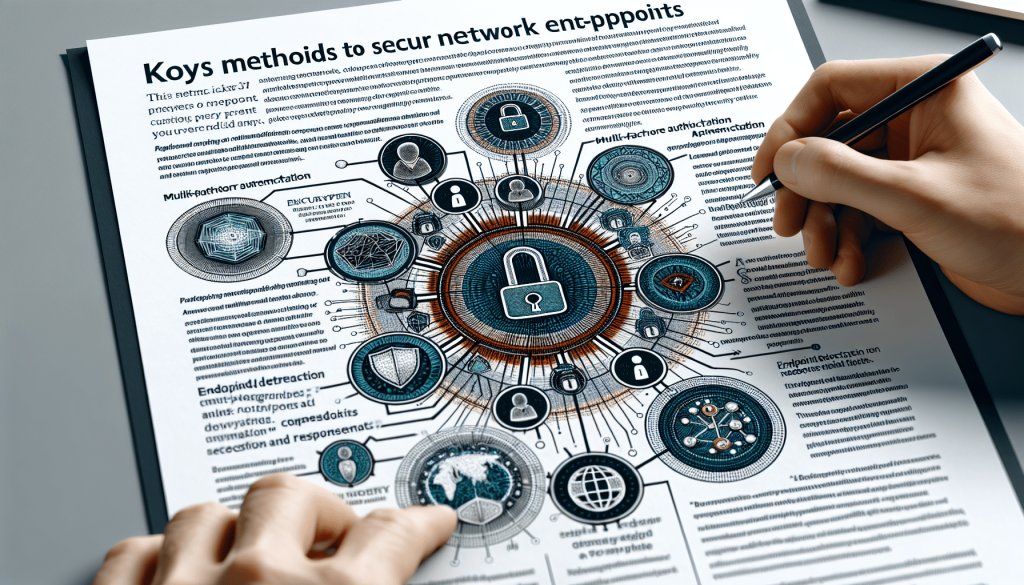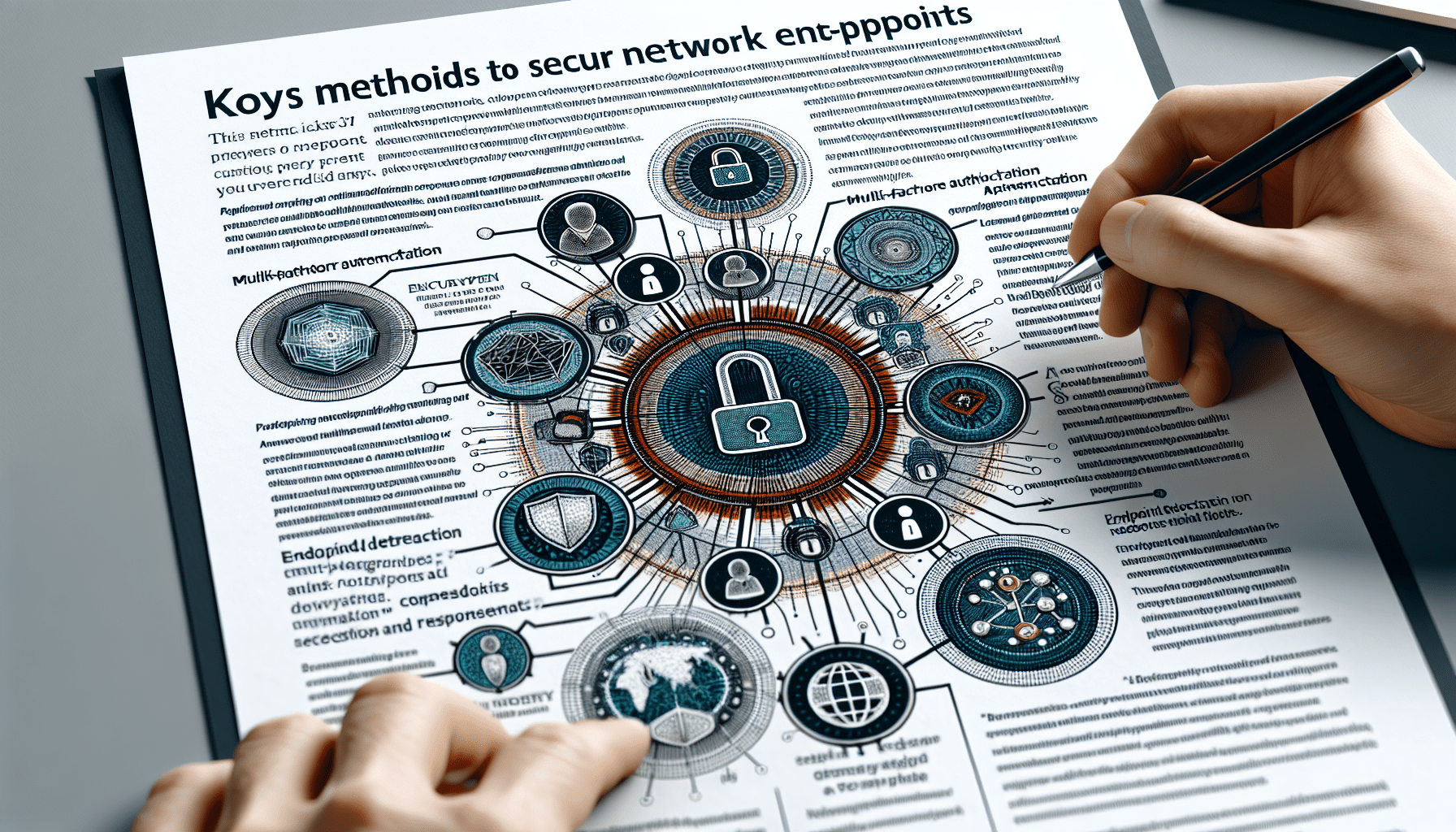Securing your network endpoints is crucial in today’s digital landscape. As cyber threats continue to evolve, it is essential to implement the best strategies to protect your data and avoid potential breaches. In this article, we will explore the top techniques for securing network endpoints, equipping you with the knowledge and tools needed to safeguard your network and ensure peace of mind. Whether you are a small business owner or an individual concerned about online security, these techniques will empower you to fortify your network endpoints effectively. So, let’s dive in and discover the best strategies for keeping your data safe.
Antivirus Software
Real-time scanning
One of the key features of antivirus software is real-time scanning. This ensures that any files or programs that you download or receive through email are instantly checked for any potential threats. Real-time scanning runs in the background, constantly monitoring your system for any suspicious activity and quickly identifying and quarantining any malware it detects. By having antivirus software with real-time scanning enabled, your computer is protected from viruses, trojans, worms, and other malicious software that may try to infect your system.
Regular updates
In order to effectively protect your computer against the ever-evolving landscape of cyber threats, it is crucial to regularly update your antivirus software. These updates include the latest virus definitions, which are essential for the software to recognize and eliminate new and emerging threats. Antivirus companies consistently work on detecting and creating solutions for new malware, and by updating your antivirus software regularly, you ensure that you have the most up-to-date protection for your system.
Scheduled scans
Aside from real-time scanning, it is also important to schedule regular full system scans with your antivirus software. These scans thoroughly search your entire computer for any existing malware or potential threats that may have bypassed the real-time scanning. By running scheduled scans, you can be confident that your system is clean and any hidden malware is detected and eliminated. It is recommended to schedule these scans during times when you are not actively using your computer, as they can be resource-intensive and may slow down your machine temporarily.
Firewalls
Hardware firewalls
A hardware firewall is a physical device that is installed between your computer and the internet. It acts as a barrier, filtering and monitoring all incoming and outgoing network traffic. Hardware firewalls provide an additional layer of security by inspecting packets of data and blocking any unauthorized or potentially dangerous connections. They are typically used in larger network environments, such as businesses, where multiple computers need to be protected simultaneously. Hardware firewalls are known for their high level of security and are effective in preventing unauthorized access to your network.
Software firewalls
Software firewalls, on the other hand, are installed directly on your computer and provide protection at the individual device level. These firewalls are designed to monitor network traffic coming in and out of your computer, and they allow you to control which applications and services are allowed to access the internet. Software firewalls are particularly useful for laptops and personal computers, as they provide an additional layer of security when connected to different networks, such as public Wi-Fi. They can help prevent unauthorized access to your computer and protect your personal data from being compromised.
Configuring firewall rules
Both hardware and software firewalls rely on the configuration of firewall rules to determine what network traffic is allowed and what should be blocked. Firewall rules can be customized based on your specific needs and requirements. For example, you can create rules to block specific IP addresses or port numbers, or allow access only to certain applications. It is important to regularly review and update your firewall rules to ensure that they align with your current network setup and security policies. By configuring firewall rules effectively, you can better protect your network and limit potential vulnerabilities.

Patch Management
Identifying vulnerabilities
Patch management is a critical aspect of network endpoint security. It involves identifying vulnerabilities in your operating system and software applications and applying patches or updates to address these vulnerabilities. Vulnerabilities can arise from various factors, such as software bugs, coding errors, or newly discovered security weaknesses. Regularly scanning your system for vulnerabilities is crucial in order to identify potential entry points for attackers and proactively secure your network endpoints.
Applying patches and updates
Once vulnerabilities are identified, it is important to promptly apply the necessary patches and updates provided by software vendors. These patches often contain fixes and security enhancements that address the identified vulnerabilities. It is recommended to download and install updates directly from the official websites of the software vendors, as this ensures that you are getting legitimate and trustworthy updates. By keeping your operating system and applications up to date, you can close potential security holes and reduce the risk of exploitation by cybercriminals.
Testing patches
Before implementing patches on your live network environment, it is essential to test them in a controlled environment. Testing patches allows you to assess their compatibility with your existing system and verify that they do not introduce any new issues or conflicts. Patches that are not properly tested may cause system instability or disrupt critical functionality. You can set up a separate test environment or use virtualization technology to safely evaluate the effects of patches before deploying them on your production network. By conducting thorough patch testing, you can mitigate the risk of introducing unforeseen problems while ensuring the security of your network endpoints.
Network Segmentation
Creating separate subnetworks
Network segmentation involves dividing a large network into smaller, separate networks known as subnetworks or subnets. This approach helps enhance network security by isolating different areas or departments within your organization. By segmenting your network, you can limit the potential impact of a security breach, as an attacker who gains access to one subnet will have a more difficult time moving laterally across the network. Each subnet can be assigned its own unique IP address range, making it easier to manage and control network traffic within specific areas of your organization.
Restricting communication between segments
Once subnetworks are created, it is important to restrict communication between them to further enhance network security. Implementing strict access controls and firewall rules between subnets ensures that only authorized network traffic is allowed to flow between segments. This can help prevent unauthorized access or lateral movement by cyber attackers who have gained access to one part of your network. By restricting communication between segments, you can limit the potential impact of a breach and isolate any malicious activity to a specific subnet, making it easier to identify and mitigate security threats.
Implementing access controls
Network segmentation also allows for the implementation of access controls, which can further secure your network endpoints. By assigning appropriate access permissions to users or devices, you can ensure that each subnet is only accessible to authorized individuals or systems. This prevents unauthorized users or devices from accessing sensitive resources or systems that they should not have access to. Access controls can be applied at different levels, such as user accounts, network devices, or specific applications. By implementing access controls effectively, you can strengthen the security of your network endpoints and safeguard critical data.

Intrusion Detection and Prevention Systems
Monitoring network traffic
Intrusion Detection and Prevention Systems (IDPS) are designed to monitor network traffic and identify any suspicious or potentially malicious activities. By analyzing network packets, IDPS can detect patterns or signatures associated with known attack methods or intrusion attempts. They can alert network administrators when potential threats are detected, allowing for immediate action to be taken. Monitoring network traffic in real-time provides a proactive approach to identifying and thwarting potential attacks before they can cause significant damage to your network endpoints.
Blocking malicious activities
In addition to monitoring network traffic, IDPS can also block or prevent malicious activities from occurring. With the ability to actively intervene, IDPS can automatically block connections or terminate processes that are identified as malicious or unauthorized. This real-time response helps to prevent further compromise of network endpoints and limits the potential impact of an attack. By combining monitoring capabilities with active prevention measures, IDPS provides a comprehensive security solution for protecting your network and endpoints from various threats.
Analyzing attack patterns
IDPS solutions also analyze attack patterns to identify any new or emerging threats that may not have known signatures or patterns. By leveraging machine learning algorithms and behavior analysis, IDPS can detect anomalies in network traffic and highlight potential threats that may have evaded traditional signature-based detection methods. Analyzing attack patterns allows for the continuous improvement of security measures, as it helps to identify new attack vectors and develop appropriate countermeasures. With the ever-evolving nature of cyber threats, this proactive approach is crucial in staying one step ahead of potential attackers.
Endpoint Encryption
Encrypting data at rest
Endpoint encryption refers to the process of encrypting data that is stored on your computer’s hard drive or other storage devices. By encrypting the data at rest, you ensure that even if the physical device falls into the wrong hands, the data remains secure and inaccessible without the encryption key. Endpoint encryption uses strong cryptographic algorithms to scramble the data, making it unreadable to anyone who does not have the appropriate decryption key. This prevents unauthorized access to sensitive information and protects your data from being compromised in the event of theft or loss of your device.
Securing data in transit
In addition to encrypting data at rest, it is equally important to secure data in transit. This refers to encrypting data that is being transmitted over a network, such as when you send an email or access a website. By encrypting data in transit, you ensure that the information is protected from interception or unauthorized access while it is in transit between your computer and the intended recipient. Secure communication protocols, such as HTTPS for web browsing or S/MIME for email, use encryption to establish a secure connection and encrypt the data being transmitted, providing an additional layer of security for your network endpoints.
Implementing secure communication protocols
To effectively secure your network endpoints, it is crucial to implement secure communication protocols. These protocols ensure that data transmitted between your computer and other devices or systems is encrypted and protected from unauthorized access. Common examples of secure communication protocols include SSL/TLS for secure web browsing and PGP/GPG for secure email communication. It is important to configure your applications and devices to use these protocols whenever possible to ensure that sensitive information remains confidential and secure. By implementing secure communication protocols, you can minimize the risk of data interception and maintain the privacy and integrity of your network endpoints.

User Education and Awareness
Phishing awareness training
One of the most common methods used by cybercriminals to gain unauthorized access to network endpoints is through phishing attacks. Phishing involves tricking individuals into revealing sensitive information, such as login credentials or financial details, by posing as a trustworthy entity via email or other forms of communication. Providing phishing awareness training to users is crucial in helping them identify phishing attempts and avoid falling victim to such attacks. By educating users about the telltale signs of phishing, such as suspicious email addresses, spelling mistakes, or urgent requests for personal information, you can empower them to be vigilant and protect themselves and the network from potential threats.
Social engineering awareness
Social engineering is a tactic used by attackers to manipulate individuals into divulging confidential information or performing actions that may compromise the security of network endpoints. This can include tactics such as impersonating a trusted colleague, posing as a technical support representative, or exploiting human emotions to gain compliance. By raising awareness about social engineering techniques and providing training on how to detect and respond to such attempts, users can be better equipped to recognize and thwart social engineering attacks. This education should emphasize the importance of verifying the identity of individuals or requests before sharing sensitive information or taking any actions that may expose the network to risks.
Safe browsing practices
Safe browsing practices are vital in minimizing the risk of malware infections and other online threats. Users should be educated on best practices for safe browsing, including avoiding clicking on suspicious links or downloading files from untrustworthy sources. It is important to emphasize the importance of keeping web browsers and plugins up to date, as outdated software can be vulnerable to exploits. Users should also be aware of the risks of visiting unknown or unsecured websites, as these can be breeding grounds for malware. By promoting safe browsing practices, users can play an active role in protecting themselves and their network endpoints from online threats.
Access Control
Strong passwords and multi-factor authentication
Access control plays a crucial role in securing network endpoints from unauthorized access. One of the simplest yet most effective methods of access control is the use of strong passwords. Users should be encouraged to create passwords that are unique, complex, and not easily guessable. It is important to avoid using common words or personal information, as these can be easily cracked by attackers. Additionally, implementing multi-factor authentication adds an extra layer of security by requiring users to provide additional credentials, such as a code sent to their mobile device, along with their password. This significantly reduces the risk of unauthorized access even if the password is compromised.
Role-based access control
Role-based access control (RBAC) is a method of access control that assigns permissions and privileges based on the user’s role within the organization. By defining specific roles and associated access rights, RBAC ensures that users only have access to the resources and information that are necessary for their job responsibilities. This helps minimize the risk of unauthorized access to sensitive data or systems and reduces the potential impact of a security breach. Regularly reviewing and updating role assignments is important to ensure that access rights are aligned with current job roles and responsibilities within the organization.
Monitoring and revoking access
Continuous monitoring of access rights and regularly reviewing user access privileges is essential in maintaining a secure network environment. It is important to periodically assess the access rights of individual users and revoke access for those who no longer require it or have changed roles within the organization. This ensures that only those who need access to specific resources or systems have ongoing privileges. Additionally, monitoring user access logs and flagging any suspicious or unauthorized access attempts can help detect and respond to potential security breaches in a timely manner. By effectively managing access control, you can significantly reduce the risk of unauthorized access to your network endpoints.
Continuous Monitoring
Network traffic analysis
Continuous monitoring of network traffic enables the identification of abnormal or suspicious activities within your network. By analyzing network traffic data, you can detect patterns or anomalies that may indicate the presence of malicious or unauthorized activities. Network traffic analysis allows for real-time monitoring and provides valuable insights into the behavior of devices and users on your network. This proactive approach to monitoring helps identify potential security breaches or compromises before they can cause significant damage to your network endpoints.
Log monitoring
Logs generated by various systems and applications within your network provide a wealth of information that can help in identifying security incidents or suspicious activities. Log monitoring involves regularly reviewing and analyzing these logs to identify any anomalies or indicators of compromise. By monitoring logs for events such as failed login attempts, access to sensitive files, or unusual network traffic, you can quickly identify potential security threats and take appropriate action. Log monitoring is an essential component of continuous monitoring and plays a vital role in maintaining the security of your network endpoints.
Event correlation and alerting
In order to effectively manage the large volume of data generated by continuous monitoring, event correlation and alerting mechanisms are necessary. Event correlation involves aggregating and analyzing data from multiple sources to identify patterns or relationships between different events. By correlating events, you can gain a more comprehensive understanding of potential security incidents and prioritize your response accordingly. Alerting mechanisms notify network administrators or security teams when predefined thresholds or conditions are met, allowing for immediate action to be taken. By implementing event correlation and alerting, you can enhance the effectiveness of continuous monitoring and respond to potential security incidents in a timely manner.
Backup and Disaster Recovery
Regularly backing up data
Data backup is a critical aspect of securing network endpoints, as it allows for the restoration of data in the event of data loss, hardware failure, or a cybersecurity incident. Regularly backing up your data ensures that you have copies of important files and information in a separate location, protecting them from potential loss or destruction. It is important to define a backup strategy that includes the frequency of backups, the types of data to be backed up, and the storage location for backups. By consistently following a backup schedule, you can minimize the impact of data loss and quickly recover from any unforeseen events.
Testing backup and recovery processes
Simply having backups in place is not enough; it is equally important to regularly test the backup and recovery processes to ensure their effectiveness. Testing involves restoring data from backups and validating that it is complete and accurate. This allows you to identify any potential issues or gaps in your backup strategy and make necessary adjustments. Testing backup and recovery processes also provide an opportunity to train and familiarize your IT team with the steps required to restore data in the event of a disaster. By conducting regular tests, you can ensure that your backups are reliable and your recovery processes are well-documented and understood by key personnel.
Offsite backup storage
Storing backups offsite is a crucial practice to protect your data from physical damage or loss due to events such as fires, floods, or theft. Offsite backup storage ensures that even if your primary location is compromised, your backups remain intact and accessible. There are various options for offsite backup storage, including cloud-based solutions and dedicated offsite backup facilities. It is important to consider the security and encryption measures in place when selecting an offsite storage solution to safeguard your data during transit and storage. By implementing offsite backup storage, you can significantly reduce the risks associated with data loss and improve the overall resilience of your network endpoints.
In conclusion, securing network endpoints requires a multifaceted approach that encompasses a combination of software and hardware solutions, user education, and consistent monitoring. By implementing antivirus software, firewalls, patch management, network segmentation, intrusion detection and prevention systems, endpoint encryption, user education, access control, continuous monitoring, and backup and disaster recovery measures, you can significantly enhance the security of your network endpoints. It is important to regularly review and update your security measures to align with emerging threats and evolving technologies. By adopting these best practices, you can protect your network endpoints from potential threats and ensure the integrity and confidentiality of your data.
